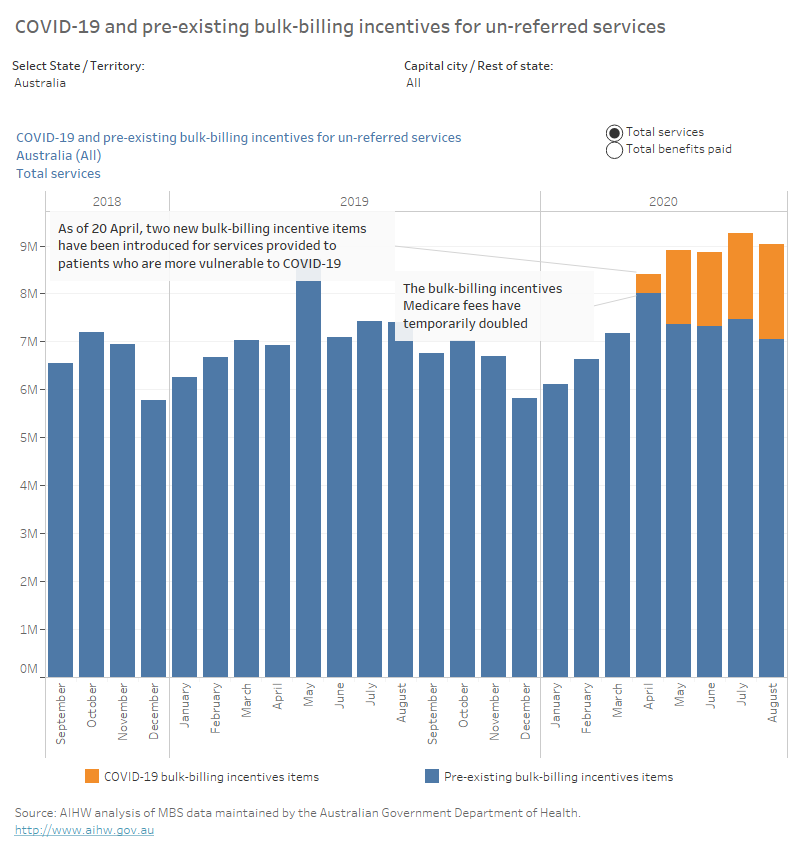Impact on MBS service use
On this page:
- National measures in response to COVID-19 related to medical services
- Impact of COVID-19 on MBS services and government benefits paid
- Impact of COVID-19 on non-hospital MBS services
- Impact of COVID-19 on in-hospital MBS services (private admitted patients and hospital substitute)
- Utilisation of COVID-19 related MBS telehealth items
- COVID-19 related MBS telehealth items for greater capital cities and rest of states
- Standard GP Attendance, COVID-19 related MBS Telehealth items
- Bulk-billing incentives for un-referred services
National measures in response to COVID-19 related to medical services
Since March 2020, the Australian Government implemented various temporary changes to support continued access to essential health care and to reduce the spread of COVID-19.
The temporary measures include:
- The temporary suspension of non-urgent elective surgeries effective from 26 March 2020. The Australian Government via the National Cabinet began a staged restoration of elective surgery from 28 April 2020.
- The introduction of new MBS telehealth items made available to reduce the risk of community transmission of COVID-19, and provide protection for patients and health care providers. These changes have resulted in Medicare benefits being made available for telephone and video conferencing consultations. Details can be viewed in the MBS Changes factsheet: COVID-19 Temporary MBS Telehealth Services.
- The temporary doubling of all Medicare bulk-billing incentive fees from 13 March 2021. This measure ceased as of 1 October 2020. Details can be viewed in the COVID-19 Bulk-billing incentives Frequently Asked Questions.
Impact of COVID-19 on MBS services and government benefits paid
In order to assess the impact of the COVID-19 pandemic on the Medicare Benefits Schedule (MBS), the AIHW has conducted a comparison of twenty-four months of MBS data, from September 2018 to August 2020. These data suggest that there have been a range of impacts on MBS activity associated with the COVID-19 pandemic, including:
- Both total services and total benefits in March 2020 were slightly higher than March 2019 (1.0% and 0.3% respectively).
- Following a rise in COVID-19 case numbers and the introduction of restrictions, including on elective surgery, total services and benefits paid in April 2020 declined by 10.2% and 7.8% respectively, compared with April 2019.
- By July 2020 both total services and total benefits paid had recovered and showed an increase of 6.6% on total service and 12.5% on total benefits paid compared with July 2019.
Figure 1.1: Total MBS services for all Broad Type of Service group, in-hospital and non-hospital, Australia, September 2018 to August 2020
This bar chart presents MBS summary statistics for hospital and non-hospital services, by month of processing, from September 2018 to August 2020. Depending on selection, statistics can be presented on number of services by broad type of service group, and by region within state/territory. A vertical reference line shows the suspension of elective non-urgent surgery on the 26th of March 2020.
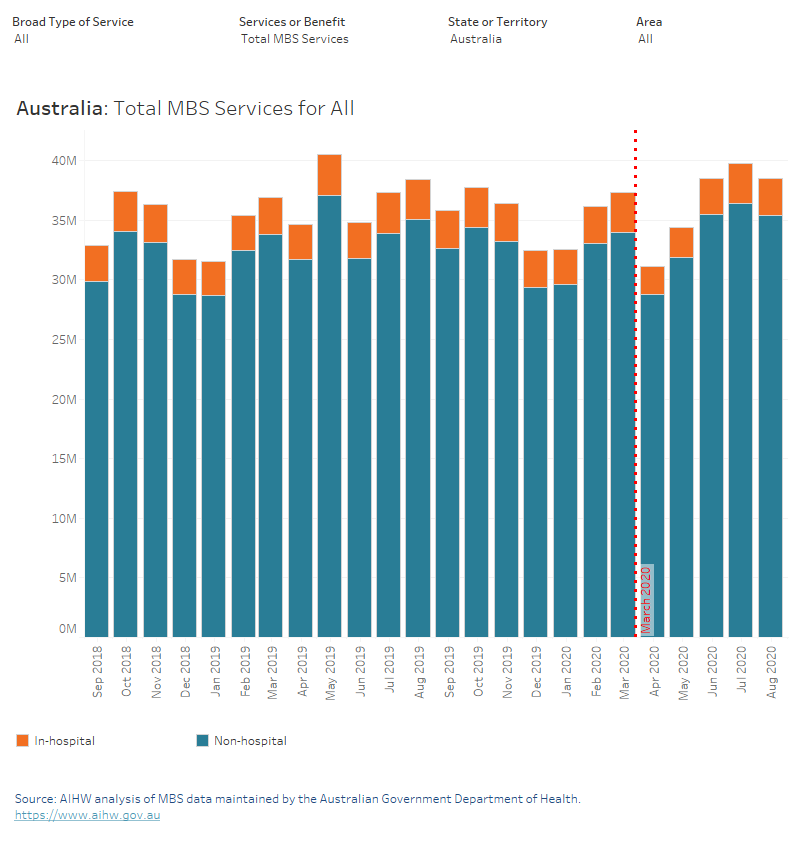
Figure 1.2: Total MBS benefits paid for all Broad Type of Service groups, in-hospital and non-hospital, Australia, September 2018 to August 2020
This bar chart presents MBS summary statistics for hospital and non-hospital services, by month of processing, from September 2018 to August 2020. Depending on selection, statistics can be presented on benefits paid by broad type of service group, and by region within state/territory. Suspension of elective non-urgent surgery was on the 26th of March 2020.

In terms of the different types of services according to Broad Type Of Service (BTOS), total services for GP attendances increased while benefits paid decreased slightly in April 2020. Specialist attendances showed a decrease in April 2020 with a gradual recovery in the subsequent months. In particular, both services and benefits paid for specialist attendances, surgical operations, pathology and diagnostic imaging decreased in April 2020 compared with March 2020, and compared with April 2019, but recovered in May 2020 and were back to pre-pandemic levels by July 2020.
Optometry services experienced a decline (both services and benefits paid) in April 2020, when many optometry practices were closed.
Total services for the “Other MBS” group declined while benefits paid increased in April 2020 compared with March 2020, which was due to the increase in benefits for bulk-billing incentives for un-referred services.
Figure 1.3: Total MBS benefits paid for Other MBS, in-hospital and non-hospital, September 2018 to August 2020
This line chart presents MBS summary statistics for the Broad Type of Service group ‘other MBS’ for hospital and non-hospital services, by month of processing, from September 2018 to August 2020. Depending on selection, statistics can be presented on benefits paid by broad type of service group, and by region within state/territory. Suspension of elective non-urgent surgery was on the 26th of March 2020.
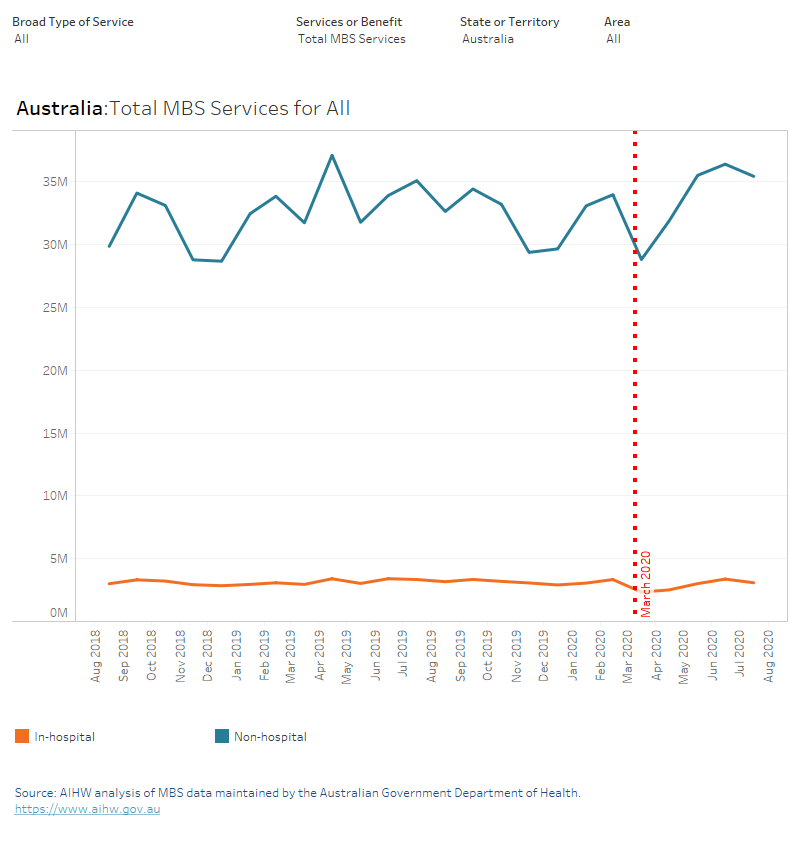
Figure 1.4: Total MBS benefits paid for Optometry services, in-hospital and non-hospital, Australia, September 2018 to August 2020
This line chart presents MBS summary statistics for the Broad Type of Service group ‘optometry’ for hospital and non-hospital services, by month of processing, from September 2018 to August 2020. Depending on selection, statistics can be presented on benefits paid by broad type of service group, and by region within state/territory. Suspension of elective non-urgent surgery was on the 26th of March 2020.
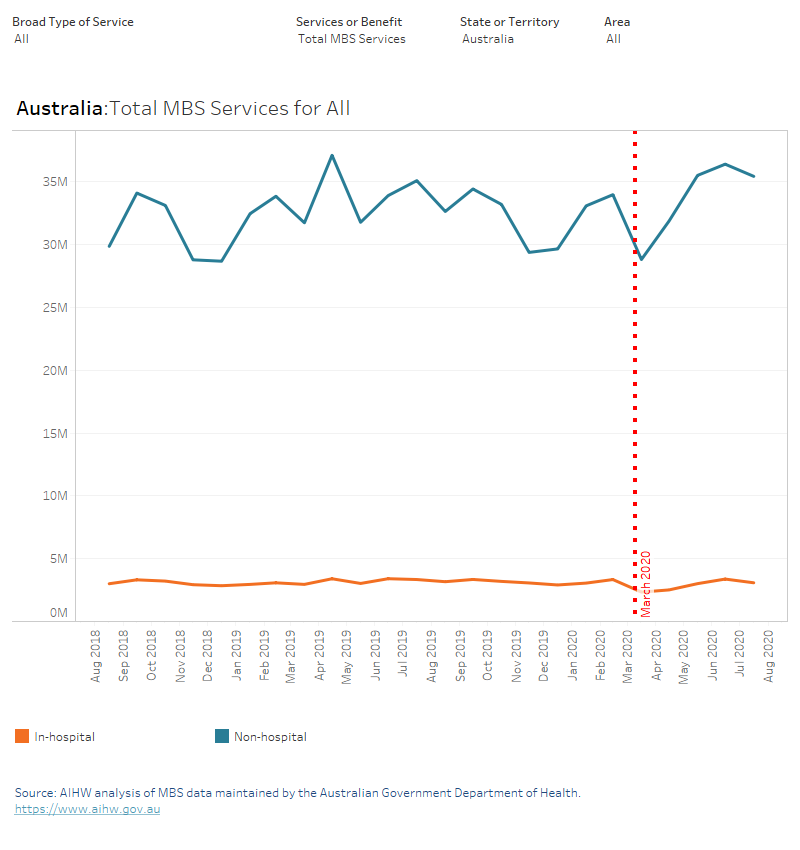
Impact of COVID-19 on non-hospital MBS services
Nationally, there was a fall in the total number of out-of-hospital services from 34.0 million in March 2020 to 28.8 million in April 2020. The total number of services increased in July/August:
- For the BTOS group “Non-referred GP attendances”, the number of services remained stable between March and August nationally. This pattern was seen across all states and territories. For some service types the impact of the shutdown in response to the first wave of COVID-19 was more marked. This stable pattern was likely influenced by the introduction of new telehealth and telephone items into the MBS in March 2020.
- For “Specialist attendances”, “Pathology”, “Diagnostic imaging” and “Optometry” services and benefits paid decreased in April 2020 compared with March 2020, and compared with April 2019, but recovered in May 2020 and were back to pre-pandemic levels by July 2020.
- “Other MBS” had a decline in services in April 2020 but total benefits increased in benefits increased due to bulk-billing incentives "Un-referred" services.
Figure 1.5: Total MBS services for Pathology services, in-hospital and non-hospital, Australia, September 2018 to August 2020
This line chart presents MBS summary statistics for the Broad Type of Service group ‘pathology’ for hospital and non-hospital services, by month of processing, from September 2018 to August 2020. Depending on selection, statistics can be presented on benefits paid by broad type of service group, and by region within state/territory. Suspension of elective non-urgent surgery was on the 26th of March 2020.

Impact of COVID-19 on in-hospital MBS services (private admitted patients and hospital substitute)
In response to the COVID-19 pandemic, restrictions were placed on elective surgery from March 2020. The data presented here mainly relates to MBS-subsidised services provided to private patients in private and public hospitals. Public patients in public hospitals are not covered by the MBS.
Nationally, there was a drop in the total number of in-hospital MBS services and benefits paid:
- Total in-hospital benefits paid in March 2020 ($276m) were higher than March 2019 ($262m) but in-hospital benefits paid in April 2020 ($185m) was lower than March 2020 and April 2019 ($243m).
- Total for in-hospital services in March 2020 (3.3m) was slightly higher than March 2019 (3.1m) but the number of services in April 2020 (2.3m) was lower than April 2019 (3.0m).
Following the easing restrictions on elective surgery, both services and benefits have bounced back to pre-pandemic levels in July/August.
Additional data relating to surgeries provided via state/territory governments can be found within the elective surgery resource.
Figure 1.6: Total MBS services by Broad Type of Service groups, in-hospital and non-hospital, September 2018 to August 2020
This line chart presents MBS summary statistics for hospital and non-hospital services, by month of processing, from September 2018 to August 2020. Depending on selection, statistics can be presented on number of services by broad type of service group, and by region within state/territory. A vertical reference line shows the suspension of elective non-urgent surgery on the 26th of March 2020.

Figure 1.7: Total MBS benefits paid for all Broad Type of Service groups, in-hospital and non-hospital, September 2018 to August 2020
This line chart presents MBS summary statistics for hospital and non-hospital services, by month of processing, from September 2018 to August 2020. Depending on selection, statistics can be presented on benefits paid by broad type of service group, and by region within state/territory. A vertical reference line shows the suspension of elective non-urgent surgery on the 26th of March 2020.
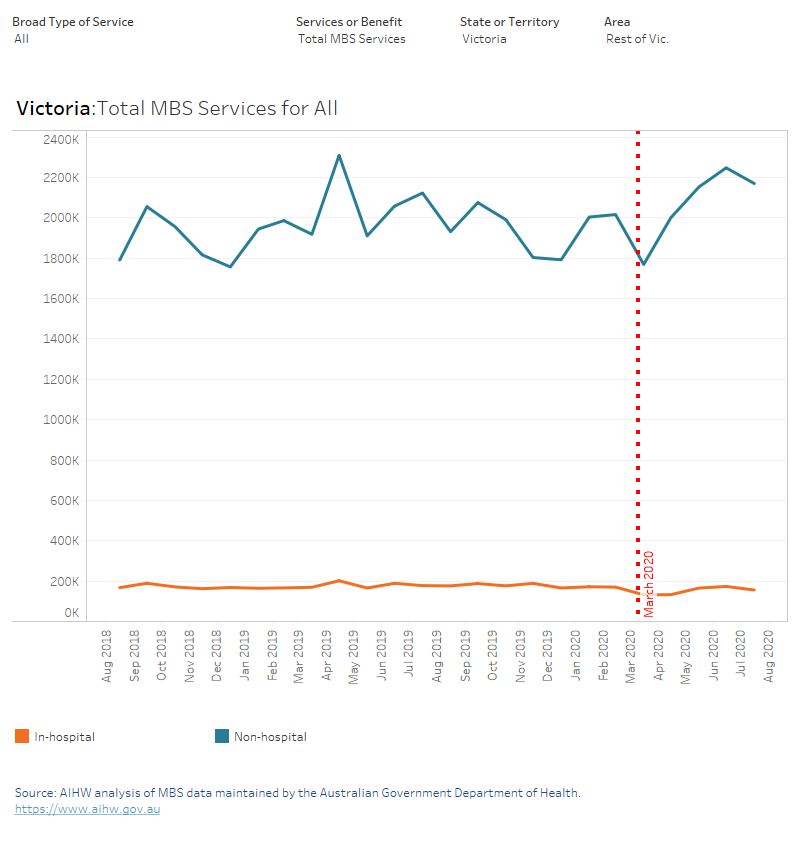
The decrease in services and benefits paid in April 2020 reflect the decrease in certain service types such as specialist attendances and surgical operations. The following months experienced growth in services and benefits, except in Victoria where there was a fall in August likely associated with their second wave of COVID-19.
Figure 1.8: Total MBS benefits paid for Specialist Attendances, in-hospital and non-hospital, September 2018 to August 2020
This line chart presents MBS summary statistics for the Broad Type of Service group ‘specialist attendances’ for hospital and non-hospital services, by month of processing, from September 2018 to August 2020. Depending on selection, statistics can be presented on benefits paid by broad type of service group, and by region within state/territory. Suspension of elective non-urgent surgery was on the 26th of March 2020.

Figure 1.9: Total MBS benefits paid for Operations, in-hospital and non-hospital, September 2018 to August 2020
This line chart presents MBS summary statistics for the Broad Type of Service group ‘operations’ for hospital and non-hospital services, by month of processing, from September 2018 to August 2020. Depending on selection, statistics can be presented on benefits paid by broad type of service group, and by region within state/territory. Suspension of elective non-urgent surgery was on the 26th of March 2020.

Utilisation of COVID-19 related MBS telehealth items
In response to the COVID-19 pandemic, from March 2020 the Australian Government introduced a range of temporary telehealth items in the MBS which allowed general practitioners (GPs), medical specialists, obstetrics and allied health professionals to also provide consultations either by telephone or videoconference. These changes were intended to reduce the risk of community transmission of COVID-19 and provide protection for both patients and health care providers.
This section of the report only focuses on the MBS items in the COVID-19 Temporary MBS Telehealth Services. The temporary MBS telehealth services items in the circular are separated into three categories, face-to-face items, telehealth items via video-conference, and telephone items for when video-conferencing is not available. The face-to-face items are pre-existing items. The telephone items and video-conference items were introduced in March 2020 in response to the COVID-19 pandemic and these items are different from those pre-existing telehealth items in the MBS.
Compared here are those service types where temporary tele-items were added alongside existing items in the MBS. As such, the categories presented are not directly comparable with the BTOS category presented earlier in this web report.
Between March and August 2020, telephone consultations by all health professionals constituted over one quarter (26%) of all telehealth items introduced in response to COVID-19 as well as the face to face equivalent items. During the same period, less than three-quarters (72%) of all services were delivered face-to-face, and 2% were delivered via video-conference.
There was some variability across different health professional groups. Please see the percentage distribution between COVID-19 related items in Table 1.
| Attendance Type | Face-to-face | Telephone | Video-conference |
|---|---|---|---|
| GP | 70% | 29% | 1% |
| Other medical practitioner | 74% | 25% | 1% |
| Specialist | 78% | 18% | 4% |
| Obstetrics | 89% | 9% | 2% |
| Allied health | 81% | 9% | 10% |
The change in mode of delivery was most pronounced in April 2020. While the total number of consultations increased by 16% when compared to April 2019, face-to-face consultations decreased, dropping 24% when compared to April 2019. This decrease in face-to-face consultations was offset by a large volume of consultations delivered via telephone and video-conference.
Figure 1.10: Total MBS services and benefits paid for COVID-19 related items by mode of delivery, September 2018 to August 2020
This bar chart presents the number of services and benefits paid for COVID-19 related items by mode of delivery (face-to-face, telehealth consultation via telephone, and telehealth consultation via video-conference) from September 2018 to August 2020.
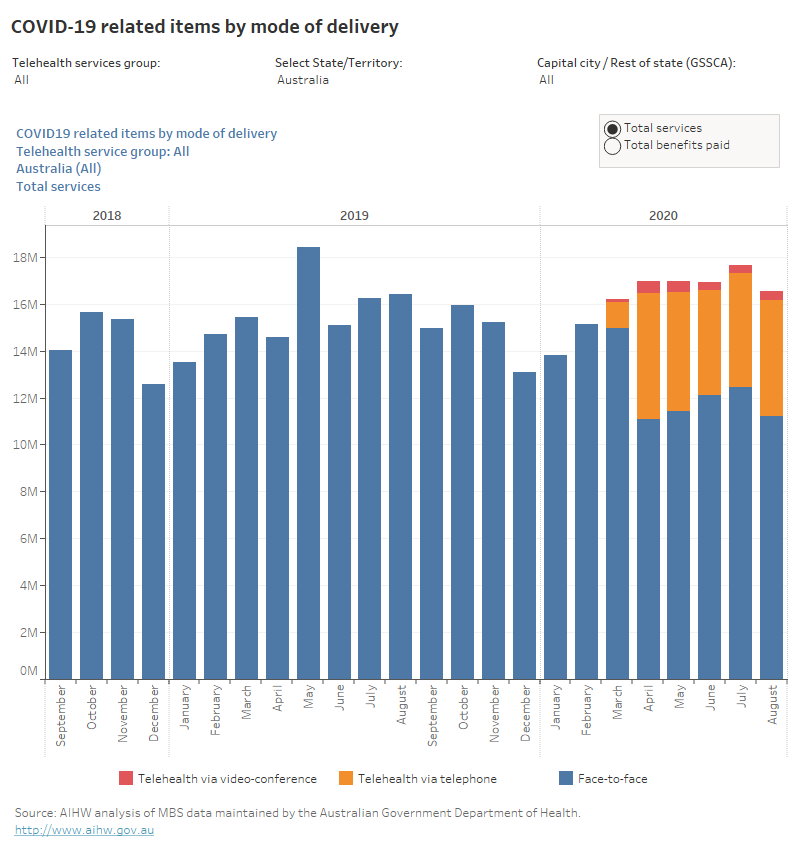
For GPs, following the introduction of telehealth items from March 2020, more than one third (36%) of the services were rendered via telephone or video-conference in April 2020.
Specialist attendances in April 2020 decreased overall (16% from March 2020) but the services rendered via telephone or video-conference increased (388% compared with March 2020).
Figure 1.11: Total MBS services for COVID-19 related items for Specialist Attendances by mode of delivery, September 2018 to August 2020
This bar chart presents the number of services for COVID-19 related specialist attendance items by mode of delivery (face-to-face, telehealth consultation via telephone, and telehealth consultation via video-conference) from September 2018 to August 2020.
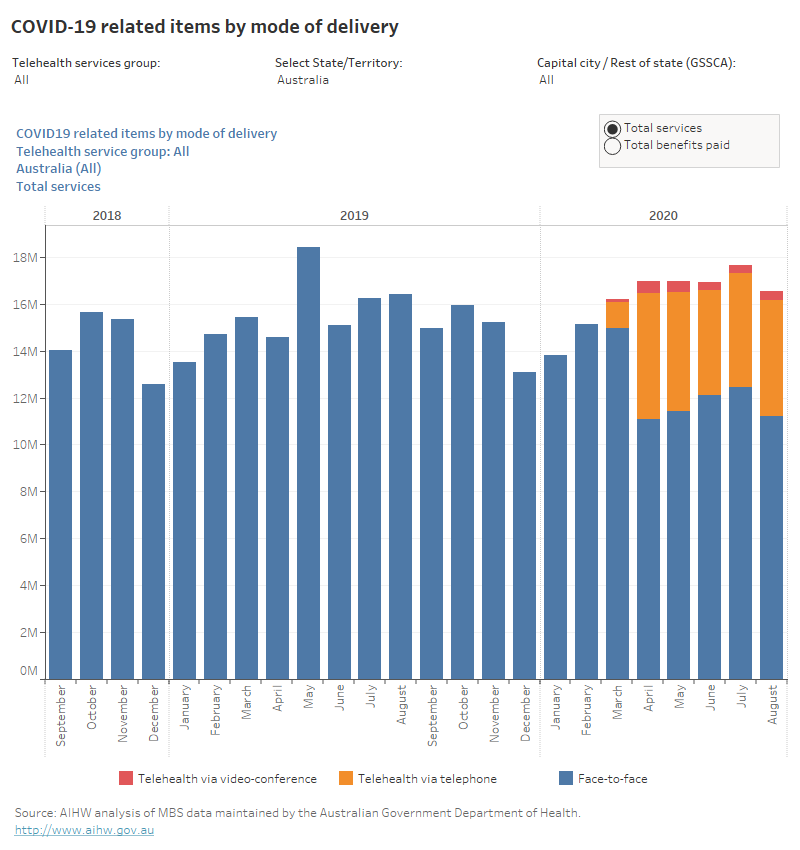
The introduction of the telehealth items did not have much impact on the overall utilisation for obstetrics consultation services. Face-to-face consultation in April 2020 reduced by about 16% compared with March 2020, but the reduction in services utilisation via face-to-face was offset by an increase of services utilisation via telephone and video-conference.
Figure 1.12: Total MBS services for COVID-19 related items for Obstetrics by mode of delivery, September 2018 to August 2020
This bar chart presents the number of services for COVID-19 related obstetrics items by mode of delivery (face-to-face, telehealth consultation via telephone, and telehealth consultation via video-conference) from September 2018 to August 2020.
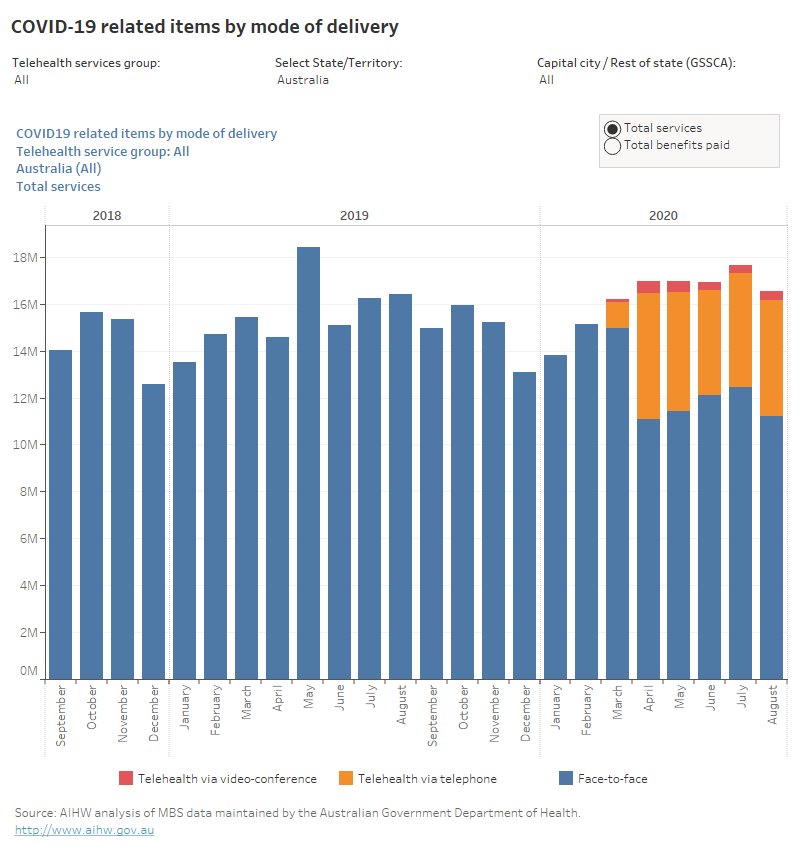
Allied health experienced a large increase in the utilisation of MBS telehealth consultations. Since April 2020 about half of the telehealth consultations were through video-conferences.
Figure 1.13: Total MBS services for COVID-19 related items for Allied Health by mode of delivery, September 2018 to August 2020
This bar chart presents the number of services for COVID-19 related allied health items by mode of delivery (face-to-face, telehealth consultation via telephone, and telehealth consultation via video-conference) from September 2018 to August 2020.
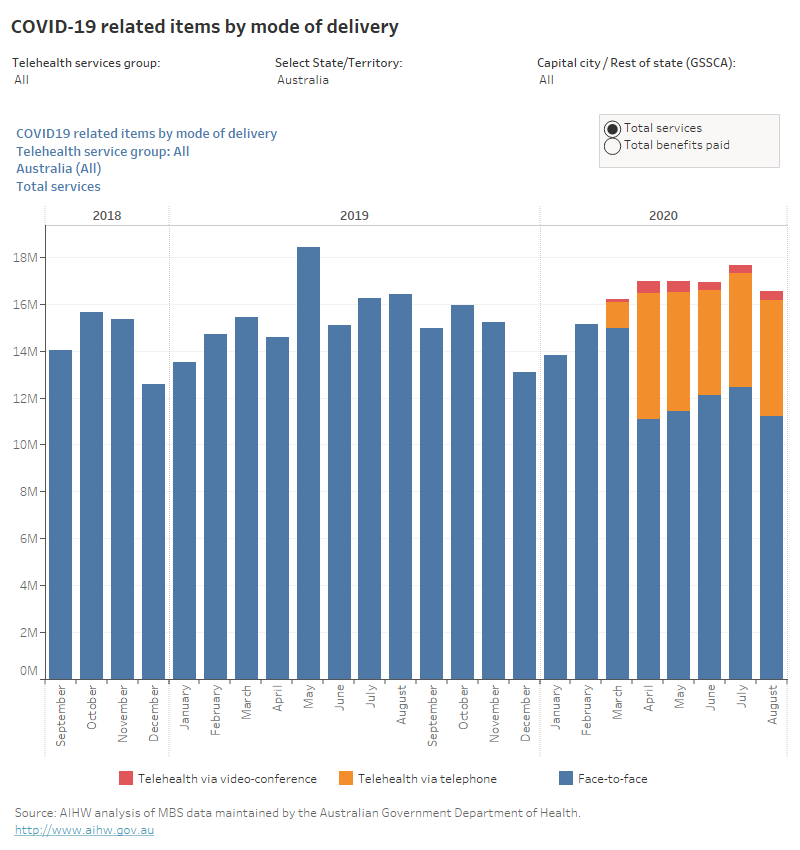
COVID-19 related MBS telehealth items for greater capital cities and rest of states
As a general trend, the number of face-to-face consultations has decreased from March 2020 across all states and territories. The findings for Greater capital city areas and Rest of state shared a similar trend in the utilisation of MBS-subsidised telehealth services in each state and territory.
For the Greater Melbourne area in Victoria, the volume of face-to-face consultations decreased in mid-March, and then stabilised in April to early May. This trend continued after the metropolitan lockdown in Melbourne on 8th July, reflecting the second wave in Victoria.
There was an increase in the utilisation of MBS services via telephone and video-conference for Greater Melbourne from March 2020, and a stabilisation between April and June. The metropolitan lockdown in Melbourne in early July saw medical practitioners switch mode of delivery from face-to-face to telephone and video-conference to a large extent.
Figure 1.14: Total MBS services and benefits paid for COVID-19 related items by mode of delivery, capital city versus rest of state, September 2018 to August 2020
This line chart presents the capital city and rest of state’s number of services and benefits paid for COVID-19 related items by mode of delivery from September 2018 to August 2020.
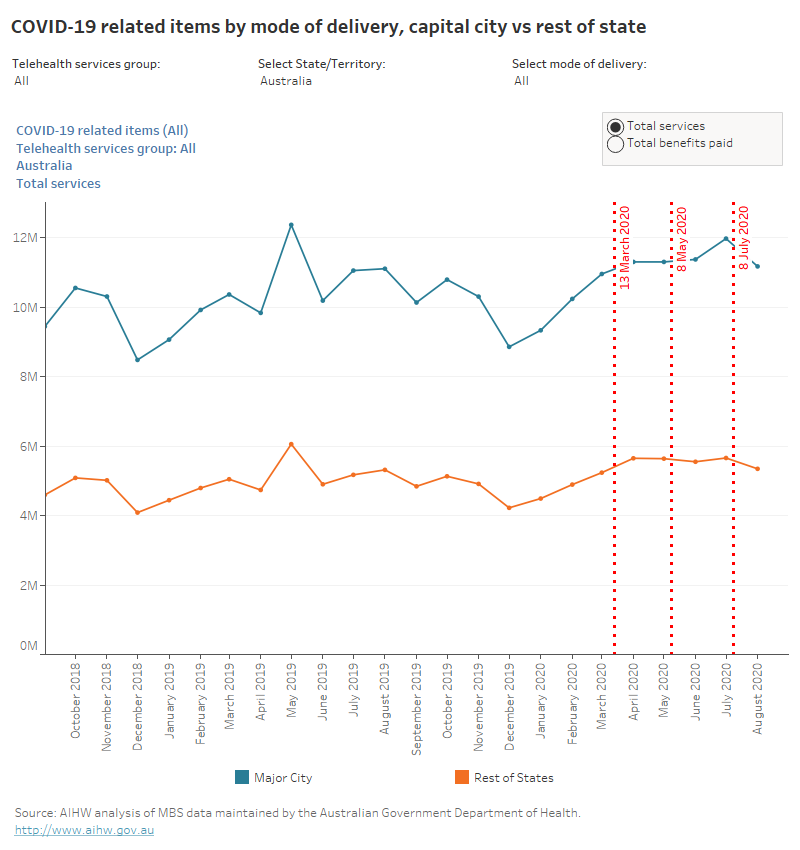
Standard GP Attendances
This section examines the Standard GP attendance items, which includes 4 categories:
- ”For an obvious problem”
- ”Less than 20 minutes”
- ”At least 20 minutes”
- ”At least 40 minutes”.
Typically, there is a seasonal pattern for Standard GP attendance for obvious problems. In May and June each year, many people have their influenza vaccinations as part of a brief GP consultation. The COVID-19 pandemic appears to have encouraged people to have their vaccinations from April and drove the services up for the “obvious problem” category. The shift for the “obvious problem” category could also be due to patients requesting prescriptions for chronic conditions. The changes can be broadly described as:
- Change of timing: The peak for the influenza vaccination was usually in May but shifted to April in 2020.
- Change of volume: The number of services for "obvious problems" in April 2020 was nearly 4 times (278% increase) the volume in March 2020, and nearly 3 times (239% increase) the volume in April 2019.
Figure 1.15: Total MBS services and benefits paid, COVID-19 related items, Standard GP attendance – obvious problem, by mode of delivery, September 2018 to August 2020
This bar chart presents the number of services and benefits paid for COVID-19 related items on the standard GP attendance category – obvious problem. The bar charts are presentable at the national level, state and territory level, and the capital city and rest of state level once the corresponding options are chosen. Time series range from September 2018 to August 2020.
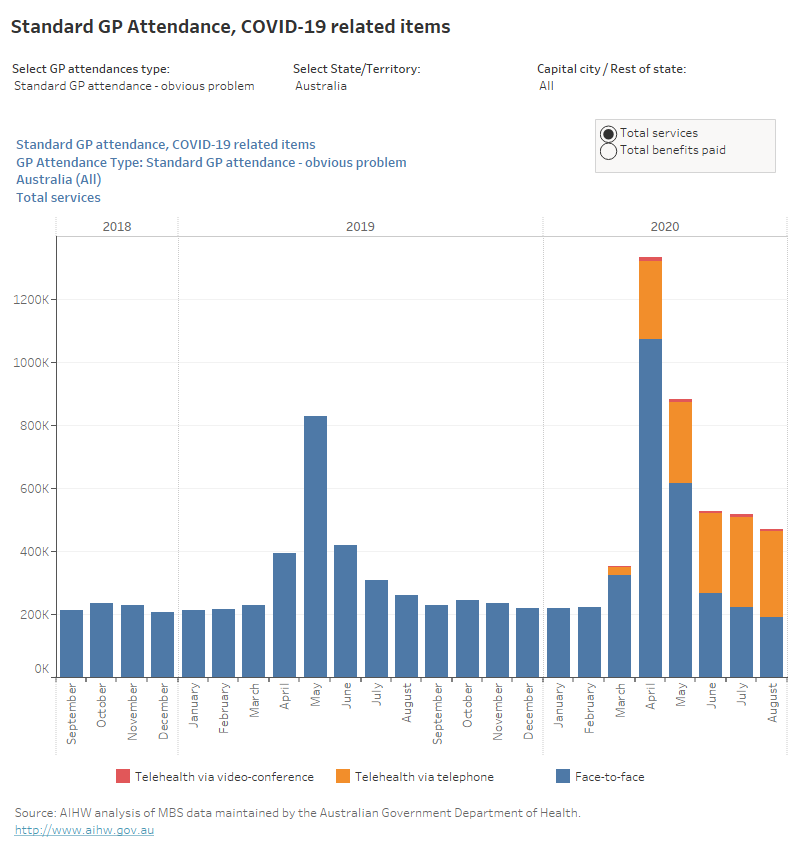
For the less than 20 minutes attendances, the total volumes from March to August 2020 increased by about 6% compared with March to August 2019, and one-third (33%) of all services in March to August 2020 were rendered via telephone or video-conference.
Figure 1.16: Total MBS services, COVID-19 related items, Standard GP attendance – less than 20 minutes, by mode of delivery, September 2018 to August 2020
This bar chart presents the number of services and benefits paid for COVID-19 related items on the standard GP attendance category – less than 20 minutes. The bar charts are presentable at the national level, state and territory level, and the capital city and rest of state level once the corresponding options are chosen. Time series range from September 2018 to August 2020.
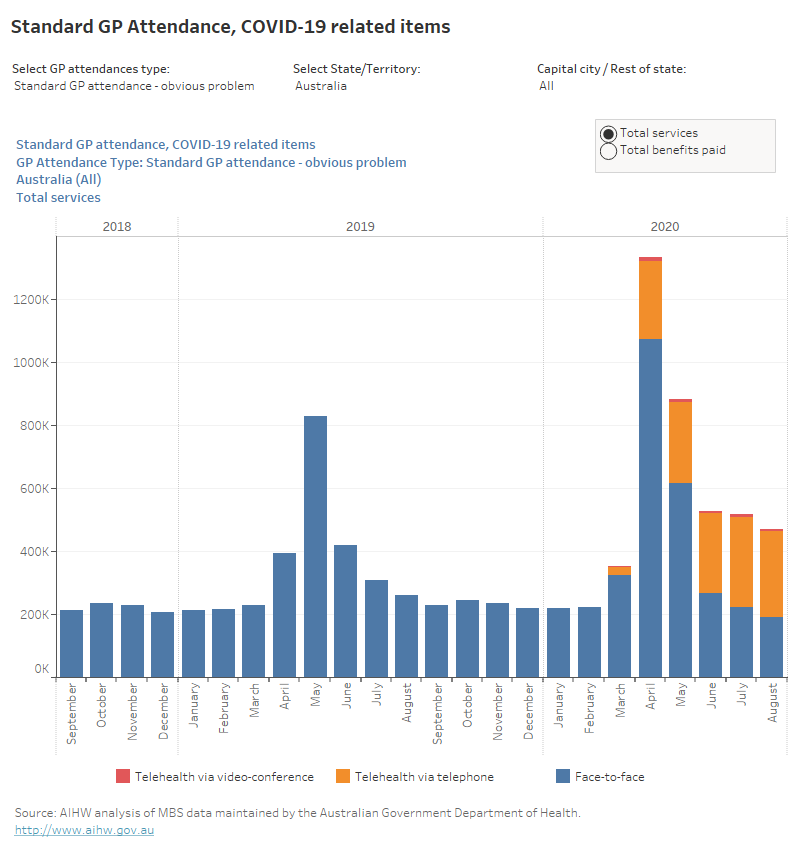
The At least 20 minutes and At least 40 minutes attendances shared a similar trend. There was a drop in April 2020 with an increase after that.
Figure 1.17: Total MBS services, COVID-19 related items, Standard GP attendance – at least 20 minutes, by mode of delivery, September 2018 to August 2020
This bar chart presents the number of services and benefits paid for COVID-19 related items on the standard GP attendance category – at least 20 minutes. The bar charts are presentable at the national level, state and territory level, and the capital city and rest of state level once the corresponding options are chosen. Time series range from September 2018 to August 2020.
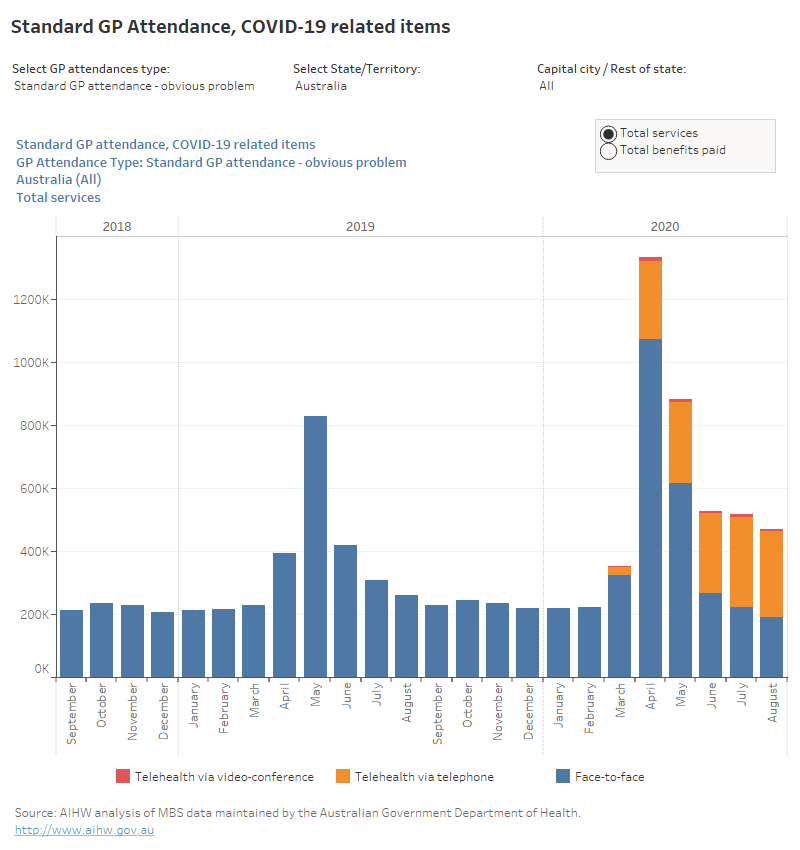
Bulk-billing incentives for un-referred services
With the introduction of the temporary MBS items in response to COVID-19, there was also a requirement for certain patient groups to be bulk-billed. This was associated with a temporary increase in benefits paid for the existing MBS bulk-billing incentive items for Un-referred services. There was an increase in bulk-billing incentive payments from $55.6 million in March 2020 to an average of $130.4 million per month between April and August 2020.
The total number of Un-referred services associated bulk-billing incentives from April to August 2020 increased by about 18% compared with the same period in 2019. The total benefit paid associated with the bulk-billing incentives more than doubled (increased by 120%) compared with the same period in 2019.
Figure 1.18: Total MBS services for COVID-19 and pre-existing bulk-billing incentives for un-referred services, September 2018 to August 2020
This bar chart presents the number of services for COVID-19 and pre-existing bulk-billing incentives for un-referred services from September 2018 to August 2020.
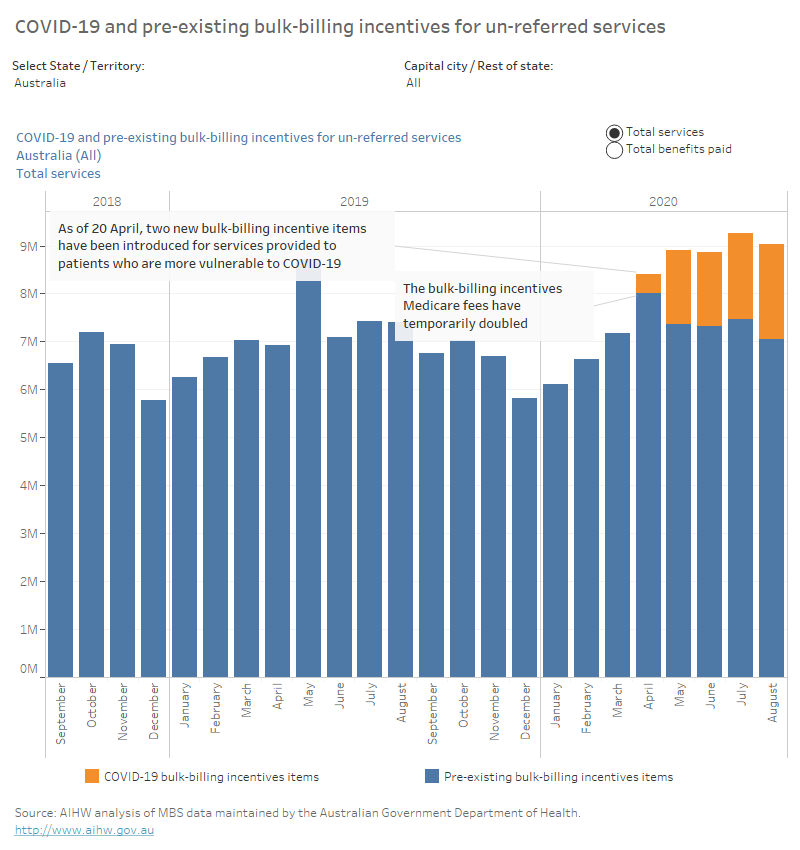
Figure 1.19: Total MBS benefits paid for COVID-19 and pre-existing bulk-billing incentives for un-referred services, September 2018 to August 2020
This bar chart presents the benefits paid for COVID-19 and pre-existing bulk-billing incentives for un-referred services from September 2018 to August 2020.
